Different Types of Companies and Their Structures
VerifiedAdded on 2022/12/28
|12
|3243
|38
AI Summary
This report examines different types of companies and their structures, including micro, small, medium, and large size businesses. It discusses sole trader, partnership, limited liability, public limited liability, and cooperative companies. The report also explores the impact of organizational structure and external factors on business productivity.
Contribute Materials
Your contribution can guide someone’s learning journey. Share your
documents today.
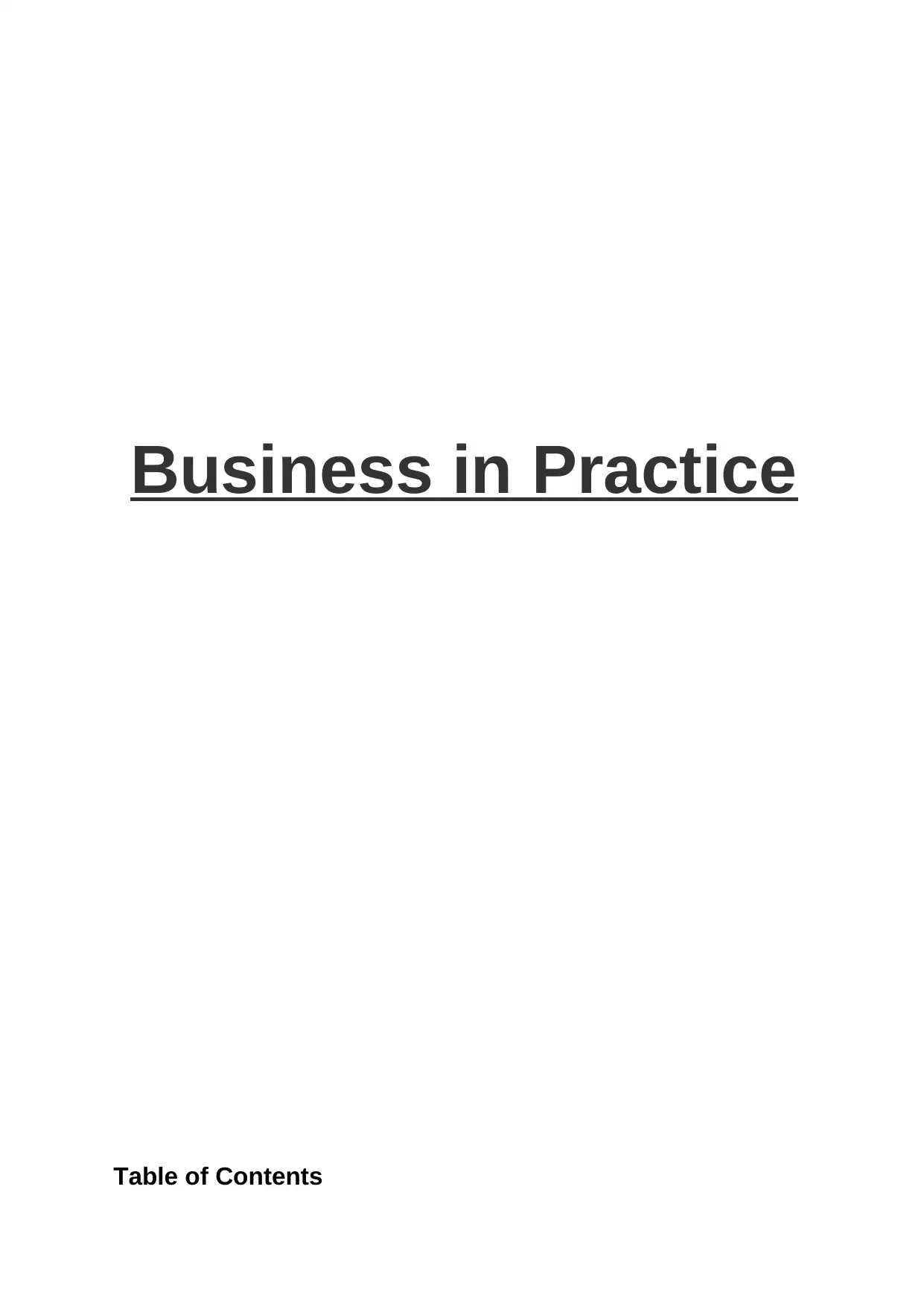
Business in Practice
Table of Contents
Table of Contents
Secure Best Marks with AI Grader
Need help grading? Try our AI Grader for instant feedback on your assignments.

Introduction.................................................................................................3
Section 1: Different types of companies and how they work .....................3
Micro business: ......................................................................................3
Small business: .......................................................................................4
Medium size business: ............................................................................4
Large size business: ...............................................................................5
Section 2: Different companies from sole traders to cooperatives and
Limited Liability Partnerships .....................................................................5
Sole trader business: ..............................................................................5
Partnership: ............................................................................................6
Limited liability business: .......................................................................7
Public limited liability business: ..............................................................7
Cooperative: ...........................................................................................7
Section 3: Different business structures and external factors affecting
business......................................................................................................8
3.1 Identification of different organizational structures and explaining
how does organisational structure affect business productivity..............8
3.2 How different external factors affect the performance of a business
– PESTLE Analysis ...................................................................................9
Conclusion.................................................................................................10
Reference List ..........................................................................................11
Section 1: Different types of companies and how they work .....................3
Micro business: ......................................................................................3
Small business: .......................................................................................4
Medium size business: ............................................................................4
Large size business: ...............................................................................5
Section 2: Different companies from sole traders to cooperatives and
Limited Liability Partnerships .....................................................................5
Sole trader business: ..............................................................................5
Partnership: ............................................................................................6
Limited liability business: .......................................................................7
Public limited liability business: ..............................................................7
Cooperative: ...........................................................................................7
Section 3: Different business structures and external factors affecting
business......................................................................................................8
3.1 Identification of different organizational structures and explaining
how does organisational structure affect business productivity..............8
3.2 How different external factors affect the performance of a business
– PESTLE Analysis ...................................................................................9
Conclusion.................................................................................................10
Reference List ..........................................................................................11
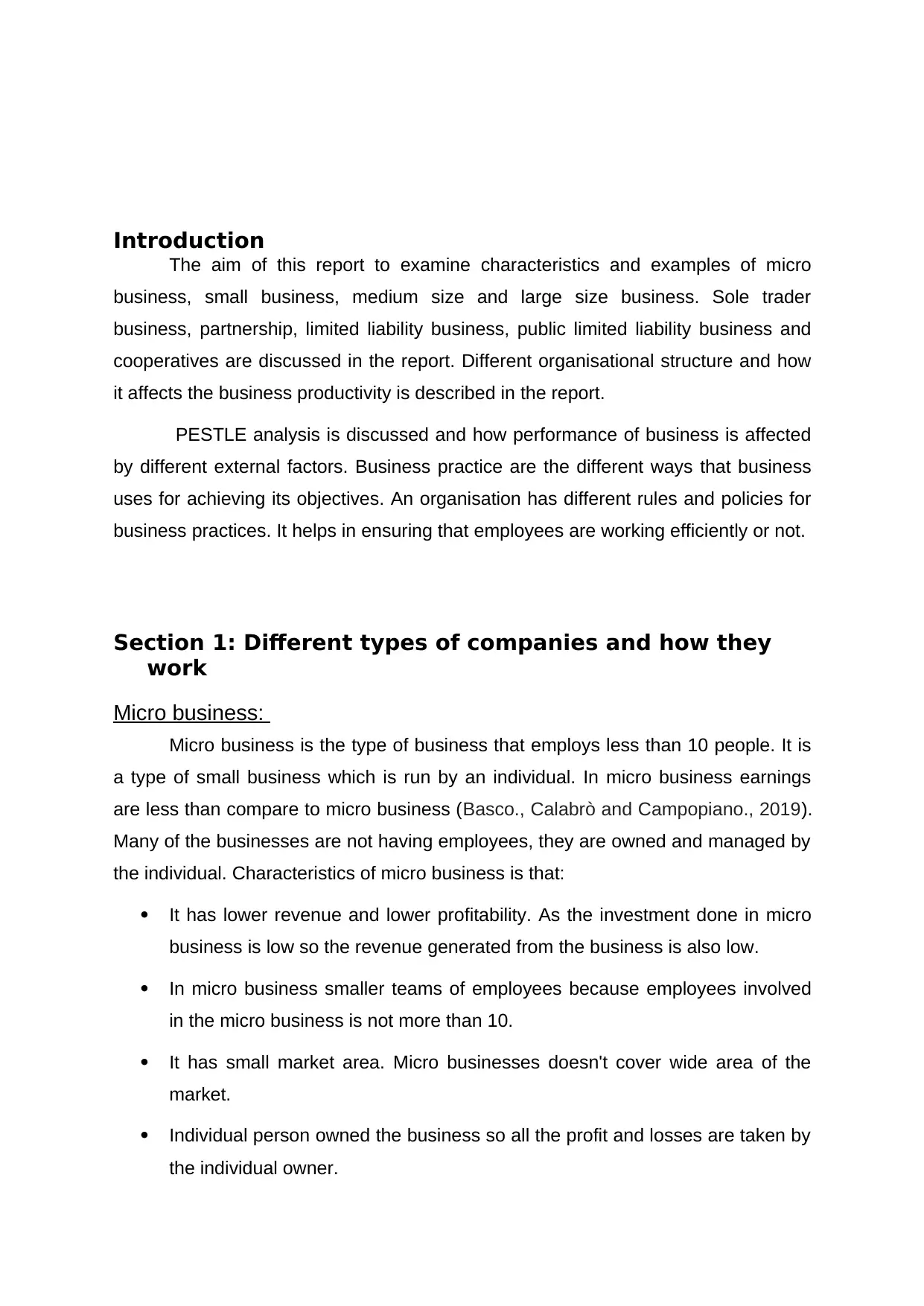
Introduction
The aim of this report to examine characteristics and examples of micro
business, small business, medium size and large size business. Sole trader
business, partnership, limited liability business, public limited liability business and
cooperatives are discussed in the report. Different organisational structure and how
it affects the business productivity is described in the report.
PESTLE analysis is discussed and how performance of business is affected
by different external factors. Business practice are the different ways that business
uses for achieving its objectives. An organisation has different rules and policies for
business practices. It helps in ensuring that employees are working efficiently or not.
Section 1: Different types of companies and how they
work
Micro business:
Micro business is the type of business that employs less than 10 people. It is
a type of small business which is run by an individual. In micro business earnings
are less than compare to micro business (Basco., Calabrò and Campopiano., 2019).
Many of the businesses are not having employees, they are owned and managed by
the individual. Characteristics of micro business is that:
It has lower revenue and lower profitability. As the investment done in micro
business is low so the revenue generated from the business is also low.
In micro business smaller teams of employees because employees involved
in the micro business is not more than 10.
It has small market area. Micro businesses doesn't cover wide area of the
market.
Individual person owned the business so all the profit and losses are taken by
the individual owner.
The aim of this report to examine characteristics and examples of micro
business, small business, medium size and large size business. Sole trader
business, partnership, limited liability business, public limited liability business and
cooperatives are discussed in the report. Different organisational structure and how
it affects the business productivity is described in the report.
PESTLE analysis is discussed and how performance of business is affected
by different external factors. Business practice are the different ways that business
uses for achieving its objectives. An organisation has different rules and policies for
business practices. It helps in ensuring that employees are working efficiently or not.
Section 1: Different types of companies and how they
work
Micro business:
Micro business is the type of business that employs less than 10 people. It is
a type of small business which is run by an individual. In micro business earnings
are less than compare to micro business (Basco., Calabrò and Campopiano., 2019).
Many of the businesses are not having employees, they are owned and managed by
the individual. Characteristics of micro business is that:
It has lower revenue and lower profitability. As the investment done in micro
business is low so the revenue generated from the business is also low.
In micro business smaller teams of employees because employees involved
in the micro business is not more than 10.
It has small market area. Micro businesses doesn't cover wide area of the
market.
Individual person owned the business so all the profit and losses are taken by
the individual owner.
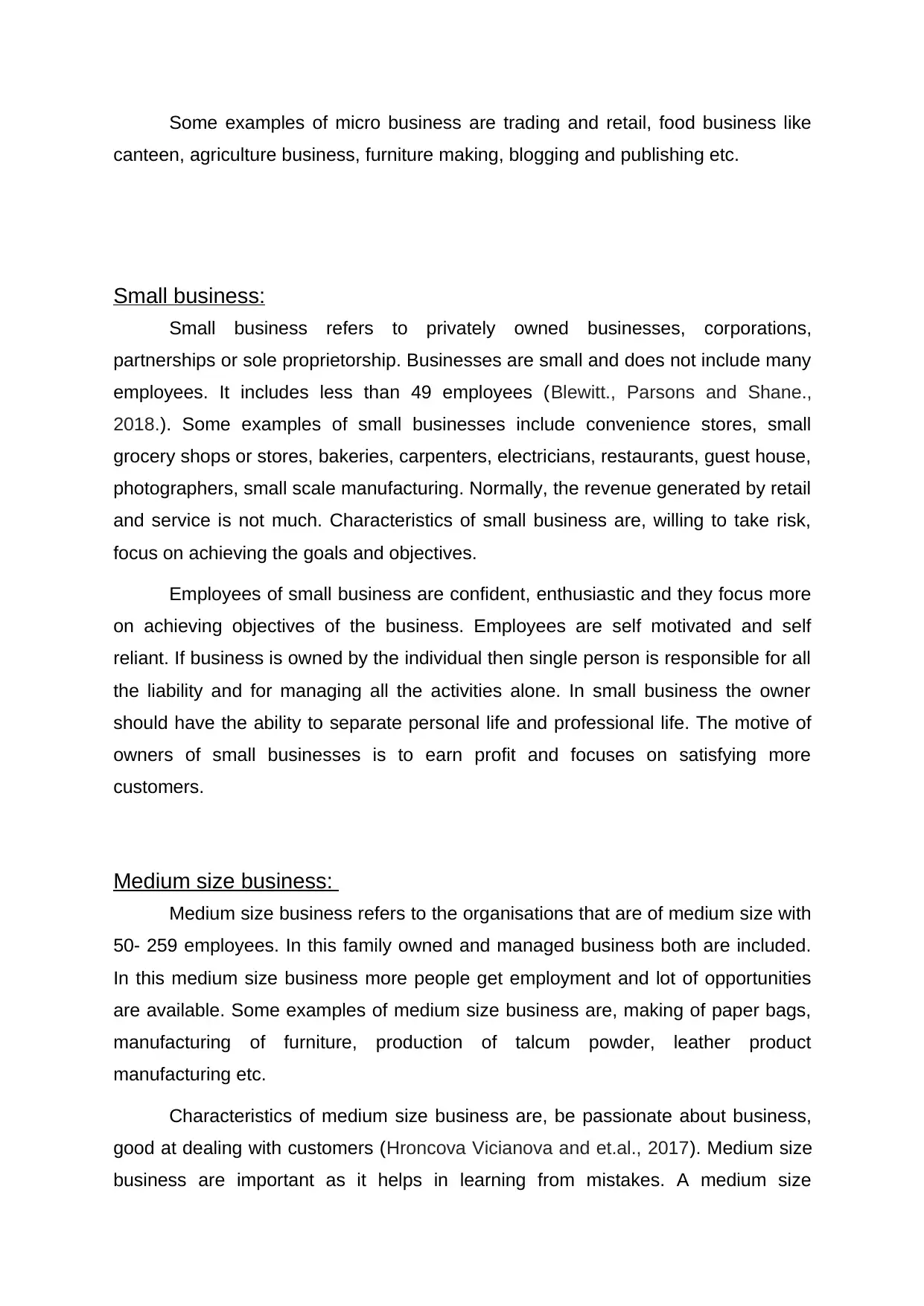
Some examples of micro business are trading and retail, food business like
canteen, agriculture business, furniture making, blogging and publishing etc.
Small business:
Small business refers to privately owned businesses, corporations,
partnerships or sole proprietorship. Businesses are small and does not include many
employees. It includes less than 49 employees (Blewitt., Parsons and Shane.,
2018.). Some examples of small businesses include convenience stores, small
grocery shops or stores, bakeries, carpenters, electricians, restaurants, guest house,
photographers, small scale manufacturing. Normally, the revenue generated by retail
and service is not much. Characteristics of small business are, willing to take risk,
focus on achieving the goals and objectives.
Employees of small business are confident, enthusiastic and they focus more
on achieving objectives of the business. Employees are self motivated and self
reliant. If business is owned by the individual then single person is responsible for all
the liability and for managing all the activities alone. In small business the owner
should have the ability to separate personal life and professional life. The motive of
owners of small businesses is to earn profit and focuses on satisfying more
customers.
Medium size business:
Medium size business refers to the organisations that are of medium size with
50- 259 employees. In this family owned and managed business both are included.
In this medium size business more people get employment and lot of opportunities
are available. Some examples of medium size business are, making of paper bags,
manufacturing of furniture, production of talcum powder, leather product
manufacturing etc.
Characteristics of medium size business are, be passionate about business,
good at dealing with customers (Hroncova Vicianova and et.al., 2017). Medium size
business are important as it helps in learning from mistakes. A medium size
canteen, agriculture business, furniture making, blogging and publishing etc.
Small business:
Small business refers to privately owned businesses, corporations,
partnerships or sole proprietorship. Businesses are small and does not include many
employees. It includes less than 49 employees (Blewitt., Parsons and Shane.,
2018.). Some examples of small businesses include convenience stores, small
grocery shops or stores, bakeries, carpenters, electricians, restaurants, guest house,
photographers, small scale manufacturing. Normally, the revenue generated by retail
and service is not much. Characteristics of small business are, willing to take risk,
focus on achieving the goals and objectives.
Employees of small business are confident, enthusiastic and they focus more
on achieving objectives of the business. Employees are self motivated and self
reliant. If business is owned by the individual then single person is responsible for all
the liability and for managing all the activities alone. In small business the owner
should have the ability to separate personal life and professional life. The motive of
owners of small businesses is to earn profit and focuses on satisfying more
customers.
Medium size business:
Medium size business refers to the organisations that are of medium size with
50- 259 employees. In this family owned and managed business both are included.
In this medium size business more people get employment and lot of opportunities
are available. Some examples of medium size business are, making of paper bags,
manufacturing of furniture, production of talcum powder, leather product
manufacturing etc.
Characteristics of medium size business are, be passionate about business,
good at dealing with customers (Hroncova Vicianova and et.al., 2017). Medium size
business are important as it helps in learning from mistakes. A medium size
Secure Best Marks with AI Grader
Need help grading? Try our AI Grader for instant feedback on your assignments.
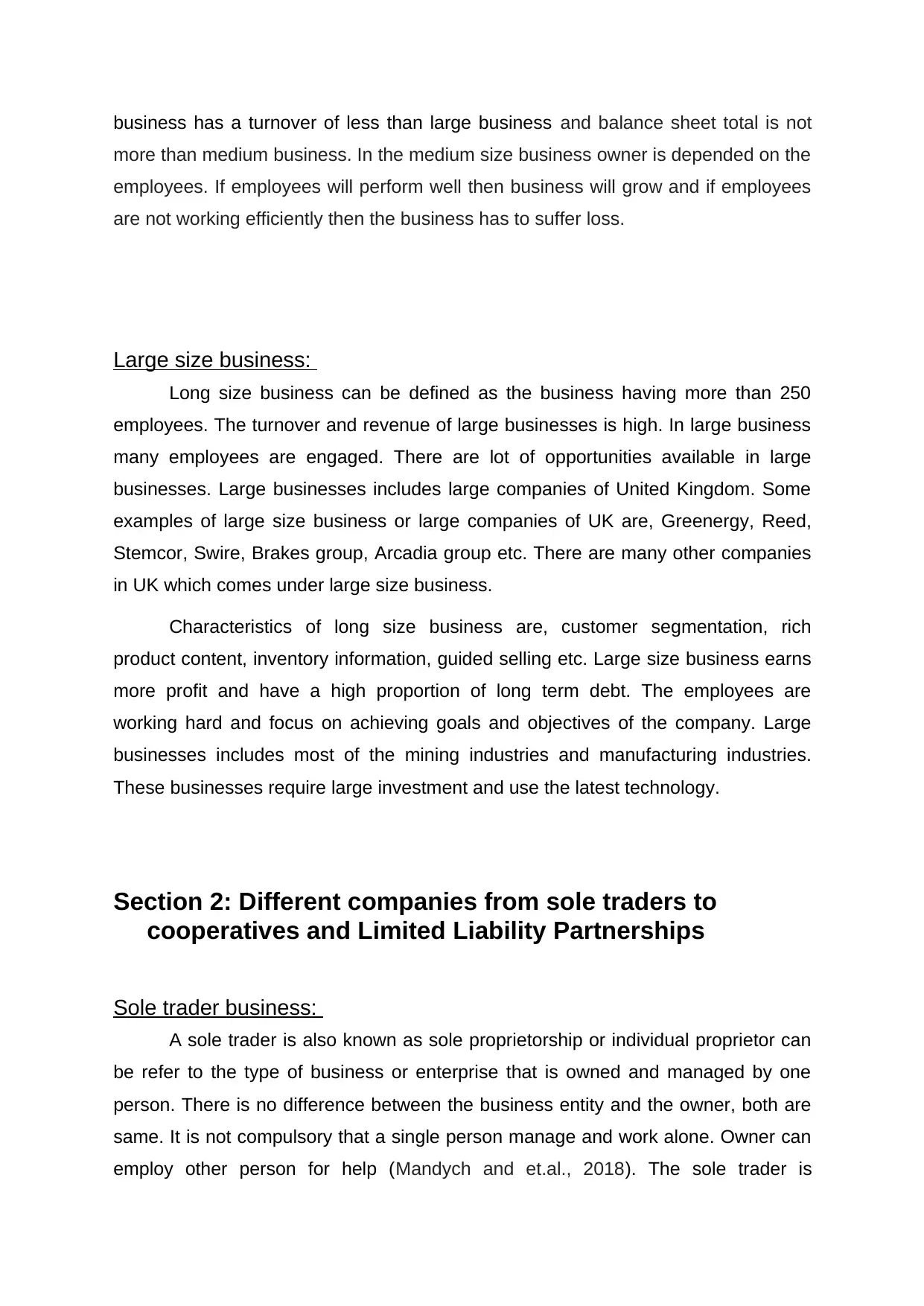
business has a turnover of less than large business and balance sheet total is not
more than medium business. In the medium size business owner is depended on the
employees. If employees will perform well then business will grow and if employees
are not working efficiently then the business has to suffer loss.
Large size business:
Long size business can be defined as the business having more than 250
employees. The turnover and revenue of large businesses is high. In large business
many employees are engaged. There are lot of opportunities available in large
businesses. Large businesses includes large companies of United Kingdom. Some
examples of large size business or large companies of UK are, Greenergy, Reed,
Stemcor, Swire, Brakes group, Arcadia group etc. There are many other companies
in UK which comes under large size business.
Characteristics of long size business are, customer segmentation, rich
product content, inventory information, guided selling etc. Large size business earns
more profit and have a high proportion of long term debt. The employees are
working hard and focus on achieving goals and objectives of the company. Large
businesses includes most of the mining industries and manufacturing industries.
These businesses require large investment and use the latest technology.
Section 2: Different companies from sole traders to
cooperatives and Limited Liability Partnerships
Sole trader business:
A sole trader is also known as sole proprietorship or individual proprietor can
be refer to the type of business or enterprise that is owned and managed by one
person. There is no difference between the business entity and the owner, both are
same. It is not compulsory that a single person manage and work alone. Owner can
employ other person for help (Mandych and et.al., 2018). The sole trader is
more than medium business. In the medium size business owner is depended on the
employees. If employees will perform well then business will grow and if employees
are not working efficiently then the business has to suffer loss.
Large size business:
Long size business can be defined as the business having more than 250
employees. The turnover and revenue of large businesses is high. In large business
many employees are engaged. There are lot of opportunities available in large
businesses. Large businesses includes large companies of United Kingdom. Some
examples of large size business or large companies of UK are, Greenergy, Reed,
Stemcor, Swire, Brakes group, Arcadia group etc. There are many other companies
in UK which comes under large size business.
Characteristics of long size business are, customer segmentation, rich
product content, inventory information, guided selling etc. Large size business earns
more profit and have a high proportion of long term debt. The employees are
working hard and focus on achieving goals and objectives of the company. Large
businesses includes most of the mining industries and manufacturing industries.
These businesses require large investment and use the latest technology.
Section 2: Different companies from sole traders to
cooperatives and Limited Liability Partnerships
Sole trader business:
A sole trader is also known as sole proprietorship or individual proprietor can
be refer to the type of business or enterprise that is owned and managed by one
person. There is no difference between the business entity and the owner, both are
same. It is not compulsory that a single person manage and work alone. Owner can
employ other person for help (Mandych and et.al., 2018). The sole trader is
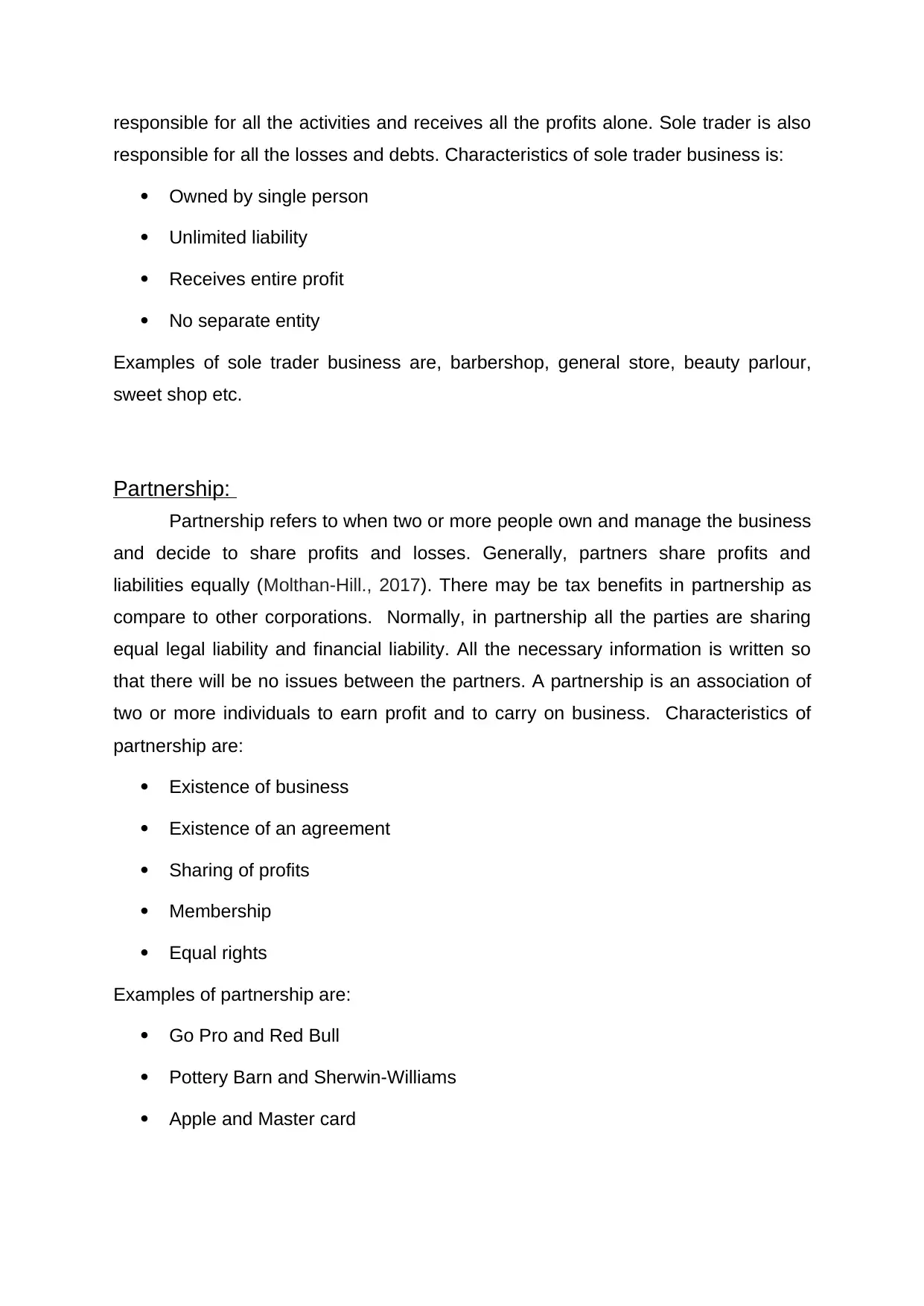
responsible for all the activities and receives all the profits alone. Sole trader is also
responsible for all the losses and debts. Characteristics of sole trader business is:
Owned by single person
Unlimited liability
Receives entire profit
No separate entity
Examples of sole trader business are, barbershop, general store, beauty parlour,
sweet shop etc.
Partnership:
Partnership refers to when two or more people own and manage the business
and decide to share profits and losses. Generally, partners share profits and
liabilities equally (Molthan-Hill., 2017). There may be tax benefits in partnership as
compare to other corporations. Normally, in partnership all the parties are sharing
equal legal liability and financial liability. All the necessary information is written so
that there will be no issues between the partners. A partnership is an association of
two or more individuals to earn profit and to carry on business. Characteristics of
partnership are:
Existence of business
Existence of an agreement
Sharing of profits
Membership
Equal rights
Examples of partnership are:
Go Pro and Red Bull
Pottery Barn and Sherwin-Williams
Apple and Master card
responsible for all the losses and debts. Characteristics of sole trader business is:
Owned by single person
Unlimited liability
Receives entire profit
No separate entity
Examples of sole trader business are, barbershop, general store, beauty parlour,
sweet shop etc.
Partnership:
Partnership refers to when two or more people own and manage the business
and decide to share profits and losses. Generally, partners share profits and
liabilities equally (Molthan-Hill., 2017). There may be tax benefits in partnership as
compare to other corporations. Normally, in partnership all the parties are sharing
equal legal liability and financial liability. All the necessary information is written so
that there will be no issues between the partners. A partnership is an association of
two or more individuals to earn profit and to carry on business. Characteristics of
partnership are:
Existence of business
Existence of an agreement
Sharing of profits
Membership
Equal rights
Examples of partnership are:
Go Pro and Red Bull
Pottery Barn and Sherwin-Williams
Apple and Master card

Limited liability business:
Limited Liability business refers to the structure of business where owners of
the company are not personally liable for the debts and liabilities of the company.
Limited liability businesses combine characteristics of corporation with partnership
and sole trader. Limited liability is easy to set up and provides protection and
flexibility. Limited liability business can be defined as owners that are responsible for
debts of the business only up to the value of their investment in the business.
The creditors can take assets of the company only. Examples of limited
liability business are, Anheuser-Busch, Blockbuster and Westinghouse etc.
Characteristics of limited liability are, all the members have limited liability, it has one
or more owners, it requires filing of documents and it is manager- managed.
Public limited liability business:
Public limited liability business refers to the business that offers shares to the
public. The buyers of the shares have limited liability. The buyers of the shares are
not responsible for any losses held by the business. They are only responsible for
the amount which they paid while purchasing the shares. It is a public company
whose shares are sold to the public at a low price.
Public limited business have a separate identity from its business. Minimum 3
directors are required to incorporate public limited business. It is a voluntary
association and has a separate legal identity. The shares of the company are freely
transferable. The decision making power is in the hands of Board of Directors.
Examples are, Bharat Heavy Electrical Ltd. Etc.
Cooperative:
A cooperative is a voluntary association in which persons united to achieve
their common economic, social and cultural needs. Cooperatives are normally
owned and managed by the members. All the members are having right to vote in
electing the Board of Directors. Cooperatives have common goals which they want
Limited Liability business refers to the structure of business where owners of
the company are not personally liable for the debts and liabilities of the company.
Limited liability businesses combine characteristics of corporation with partnership
and sole trader. Limited liability is easy to set up and provides protection and
flexibility. Limited liability business can be defined as owners that are responsible for
debts of the business only up to the value of their investment in the business.
The creditors can take assets of the company only. Examples of limited
liability business are, Anheuser-Busch, Blockbuster and Westinghouse etc.
Characteristics of limited liability are, all the members have limited liability, it has one
or more owners, it requires filing of documents and it is manager- managed.
Public limited liability business:
Public limited liability business refers to the business that offers shares to the
public. The buyers of the shares have limited liability. The buyers of the shares are
not responsible for any losses held by the business. They are only responsible for
the amount which they paid while purchasing the shares. It is a public company
whose shares are sold to the public at a low price.
Public limited business have a separate identity from its business. Minimum 3
directors are required to incorporate public limited business. It is a voluntary
association and has a separate legal identity. The shares of the company are freely
transferable. The decision making power is in the hands of Board of Directors.
Examples are, Bharat Heavy Electrical Ltd. Etc.
Cooperative:
A cooperative is a voluntary association in which persons united to achieve
their common economic, social and cultural needs. Cooperatives are normally
owned and managed by the members. All the members are having right to vote in
electing the Board of Directors. Cooperatives have common goals which they want
Paraphrase This Document
Need a fresh take? Get an instant paraphrase of this document with our AI Paraphraser
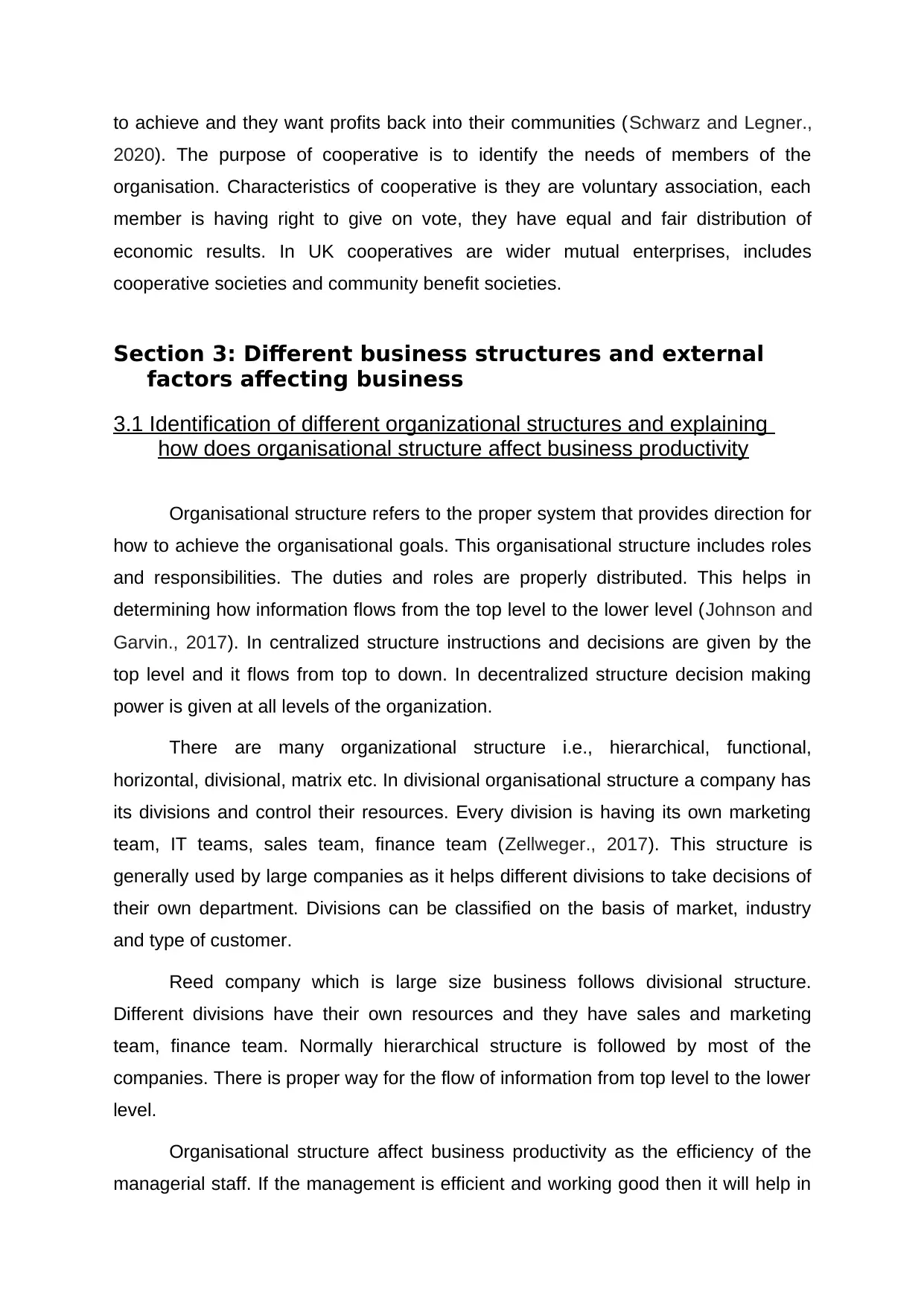
to achieve and they want profits back into their communities (Schwarz and Legner.,
2020). The purpose of cooperative is to identify the needs of members of the
organisation. Characteristics of cooperative is they are voluntary association, each
member is having right to give on vote, they have equal and fair distribution of
economic results. In UK cooperatives are wider mutual enterprises, includes
cooperative societies and community benefit societies.
Section 3: Different business structures and external
factors affecting business
3.1 Identification of different organizational structures and explaining
how does organisational structure affect business productivity
Organisational structure refers to the proper system that provides direction for
how to achieve the organisational goals. This organisational structure includes roles
and responsibilities. The duties and roles are properly distributed. This helps in
determining how information flows from the top level to the lower level (Johnson and
Garvin., 2017). In centralized structure instructions and decisions are given by the
top level and it flows from top to down. In decentralized structure decision making
power is given at all levels of the organization.
There are many organizational structure i.e., hierarchical, functional,
horizontal, divisional, matrix etc. In divisional organisational structure a company has
its divisions and control their resources. Every division is having its own marketing
team, IT teams, sales team, finance team (Zellweger., 2017). This structure is
generally used by large companies as it helps different divisions to take decisions of
their own department. Divisions can be classified on the basis of market, industry
and type of customer.
Reed company which is large size business follows divisional structure.
Different divisions have their own resources and they have sales and marketing
team, finance team. Normally hierarchical structure is followed by most of the
companies. There is proper way for the flow of information from top level to the lower
level.
Organisational structure affect business productivity as the efficiency of the
managerial staff. If the management is efficient and working good then it will help in
2020). The purpose of cooperative is to identify the needs of members of the
organisation. Characteristics of cooperative is they are voluntary association, each
member is having right to give on vote, they have equal and fair distribution of
economic results. In UK cooperatives are wider mutual enterprises, includes
cooperative societies and community benefit societies.
Section 3: Different business structures and external
factors affecting business
3.1 Identification of different organizational structures and explaining
how does organisational structure affect business productivity
Organisational structure refers to the proper system that provides direction for
how to achieve the organisational goals. This organisational structure includes roles
and responsibilities. The duties and roles are properly distributed. This helps in
determining how information flows from the top level to the lower level (Johnson and
Garvin., 2017). In centralized structure instructions and decisions are given by the
top level and it flows from top to down. In decentralized structure decision making
power is given at all levels of the organization.
There are many organizational structure i.e., hierarchical, functional,
horizontal, divisional, matrix etc. In divisional organisational structure a company has
its divisions and control their resources. Every division is having its own marketing
team, IT teams, sales team, finance team (Zellweger., 2017). This structure is
generally used by large companies as it helps different divisions to take decisions of
their own department. Divisions can be classified on the basis of market, industry
and type of customer.
Reed company which is large size business follows divisional structure.
Different divisions have their own resources and they have sales and marketing
team, finance team. Normally hierarchical structure is followed by most of the
companies. There is proper way for the flow of information from top level to the lower
level.
Organisational structure affect business productivity as the efficiency of the
managerial staff. If the management is efficient and working good then it will help in
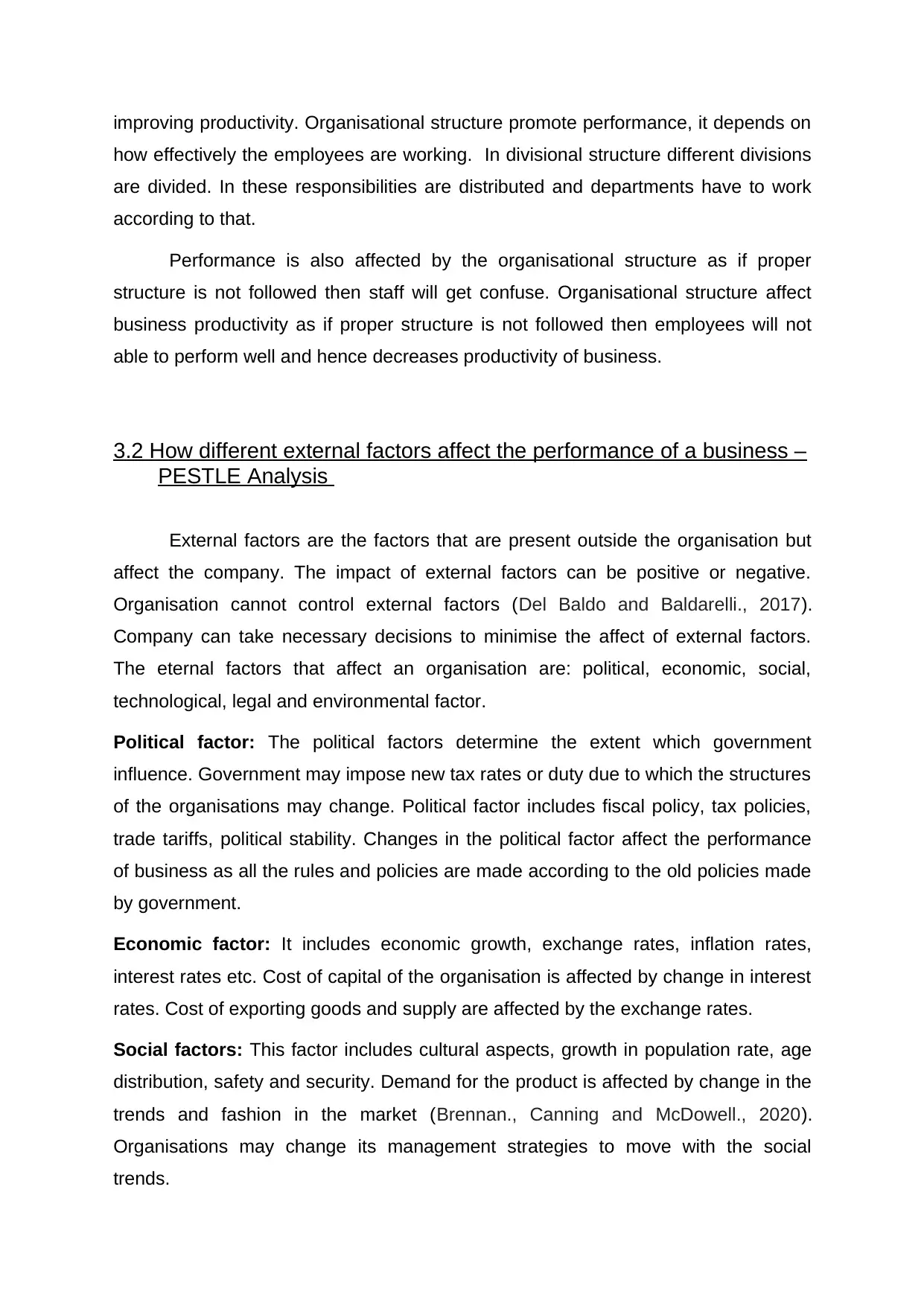
improving productivity. Organisational structure promote performance, it depends on
how effectively the employees are working. In divisional structure different divisions
are divided. In these responsibilities are distributed and departments have to work
according to that.
Performance is also affected by the organisational structure as if proper
structure is not followed then staff will get confuse. Organisational structure affect
business productivity as if proper structure is not followed then employees will not
able to perform well and hence decreases productivity of business.
3.2 How different external factors affect the performance of a business –
PESTLE Analysis
External factors are the factors that are present outside the organisation but
affect the company. The impact of external factors can be positive or negative.
Organisation cannot control external factors (Del Baldo and Baldarelli., 2017).
Company can take necessary decisions to minimise the affect of external factors.
The eternal factors that affect an organisation are: political, economic, social,
technological, legal and environmental factor.
Political factor: The political factors determine the extent which government
influence. Government may impose new tax rates or duty due to which the structures
of the organisations may change. Political factor includes fiscal policy, tax policies,
trade tariffs, political stability. Changes in the political factor affect the performance
of business as all the rules and policies are made according to the old policies made
by government.
Economic factor: It includes economic growth, exchange rates, inflation rates,
interest rates etc. Cost of capital of the organisation is affected by change in interest
rates. Cost of exporting goods and supply are affected by the exchange rates.
Social factors: This factor includes cultural aspects, growth in population rate, age
distribution, safety and security. Demand for the product is affected by change in the
trends and fashion in the market (Brennan., Canning and McDowell., 2020).
Organisations may change its management strategies to move with the social
trends.
how effectively the employees are working. In divisional structure different divisions
are divided. In these responsibilities are distributed and departments have to work
according to that.
Performance is also affected by the organisational structure as if proper
structure is not followed then staff will get confuse. Organisational structure affect
business productivity as if proper structure is not followed then employees will not
able to perform well and hence decreases productivity of business.
3.2 How different external factors affect the performance of a business –
PESTLE Analysis
External factors are the factors that are present outside the organisation but
affect the company. The impact of external factors can be positive or negative.
Organisation cannot control external factors (Del Baldo and Baldarelli., 2017).
Company can take necessary decisions to minimise the affect of external factors.
The eternal factors that affect an organisation are: political, economic, social,
technological, legal and environmental factor.
Political factor: The political factors determine the extent which government
influence. Government may impose new tax rates or duty due to which the structures
of the organisations may change. Political factor includes fiscal policy, tax policies,
trade tariffs, political stability. Changes in the political factor affect the performance
of business as all the rules and policies are made according to the old policies made
by government.
Economic factor: It includes economic growth, exchange rates, inflation rates,
interest rates etc. Cost of capital of the organisation is affected by change in interest
rates. Cost of exporting goods and supply are affected by the exchange rates.
Social factors: This factor includes cultural aspects, growth in population rate, age
distribution, safety and security. Demand for the product is affected by change in the
trends and fashion in the market (Brennan., Canning and McDowell., 2020).
Organisations may change its management strategies to move with the social
trends.

Technological factors: It includes technological aspects like change in technology,
research and development activity, automation etc. Technological factors affect the
quality of the product. Performance of business affected as organisation has to
adapt new technology to maintain its position.
Legal factor: It includes consumer law, employment law, health and safety law,
discrimination law. Legal factors affect cost and demand of the product. Performance
may be affected as organisations has to change its policies.
Environmental factors: It includes change in weather and climate, pollution,
availability of non- renewable goods which generally affects farming, tourism and
insurance companies.
Working of Amcor plc is affected by external factors such as political,
economic, social, technological, legal and environmental.
Political factor: It helps in determining factors that impact Amcor plc long term
profitability in market. The company is operating in materials and there are many
other political factors such as, trade regulations and tariff barriers. As company
operates its business in different countries, there is change in taxation policy. If
Amcor plc is exporting or importing goods then they have to pay amount for trade
barriers.
Economic factor: Factors that impact Amcor plc are, type of economic system,
unemployment rate, inflation rate, interest rates. While conducting market analysis
they should consider all these factors.
Social factor: Amcor plc is identifying target audience and decide which age group
persons should be targeted, their buying power, culture (gender roles), class
structure.
Technological factor: As trends are changing so it is difficult for companies to
move with culture. New technology is being used by competitors of Amcor plc. Other
impact of technology on the company are, impact on value chain structure, rate of
technological diffusion.
Legal factor: Amcor plc wants to enter into new market then legal factors that
should be consider are, discrimination law, employment law, health and safety law,
consumer protection etc.
research and development activity, automation etc. Technological factors affect the
quality of the product. Performance of business affected as organisation has to
adapt new technology to maintain its position.
Legal factor: It includes consumer law, employment law, health and safety law,
discrimination law. Legal factors affect cost and demand of the product. Performance
may be affected as organisations has to change its policies.
Environmental factors: It includes change in weather and climate, pollution,
availability of non- renewable goods which generally affects farming, tourism and
insurance companies.
Working of Amcor plc is affected by external factors such as political,
economic, social, technological, legal and environmental.
Political factor: It helps in determining factors that impact Amcor plc long term
profitability in market. The company is operating in materials and there are many
other political factors such as, trade regulations and tariff barriers. As company
operates its business in different countries, there is change in taxation policy. If
Amcor plc is exporting or importing goods then they have to pay amount for trade
barriers.
Economic factor: Factors that impact Amcor plc are, type of economic system,
unemployment rate, inflation rate, interest rates. While conducting market analysis
they should consider all these factors.
Social factor: Amcor plc is identifying target audience and decide which age group
persons should be targeted, their buying power, culture (gender roles), class
structure.
Technological factor: As trends are changing so it is difficult for companies to
move with culture. New technology is being used by competitors of Amcor plc. Other
impact of technology on the company are, impact on value chain structure, rate of
technological diffusion.
Legal factor: Amcor plc wants to enter into new market then legal factors that
should be consider are, discrimination law, employment law, health and safety law,
consumer protection etc.
Secure Best Marks with AI Grader
Need help grading? Try our AI Grader for instant feedback on your assignments.
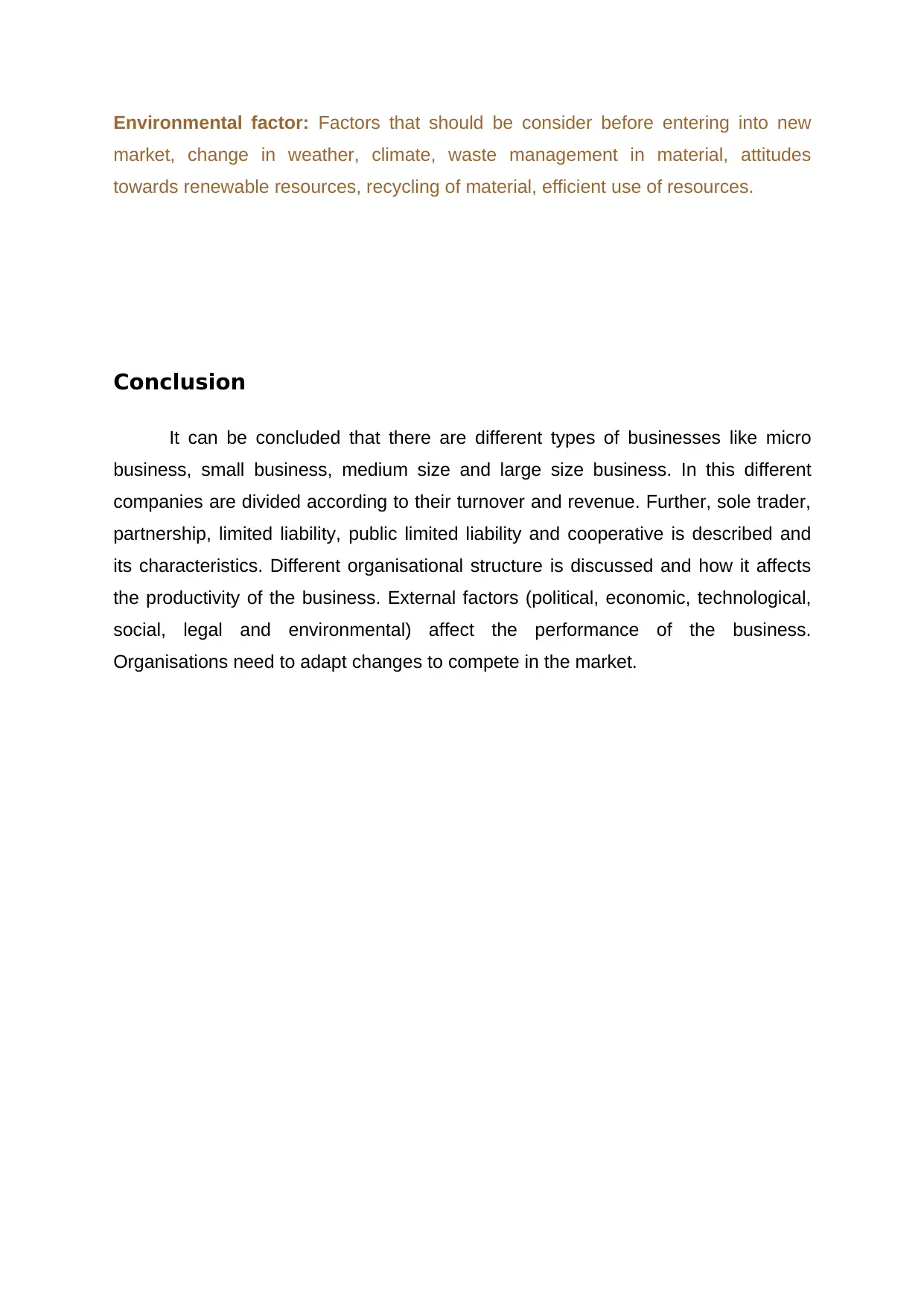
Environmental factor: Factors that should be consider before entering into new
market, change in weather, climate, waste management in material, attitudes
towards renewable resources, recycling of material, efficient use of resources.
Conclusion
It can be concluded that there are different types of businesses like micro
business, small business, medium size and large size business. In this different
companies are divided according to their turnover and revenue. Further, sole trader,
partnership, limited liability, public limited liability and cooperative is described and
its characteristics. Different organisational structure is discussed and how it affects
the productivity of the business. External factors (political, economic, technological,
social, legal and environmental) affect the performance of the business.
Organisations need to adapt changes to compete in the market.
market, change in weather, climate, waste management in material, attitudes
towards renewable resources, recycling of material, efficient use of resources.
Conclusion
It can be concluded that there are different types of businesses like micro
business, small business, medium size and large size business. In this different
companies are divided according to their turnover and revenue. Further, sole trader,
partnership, limited liability, public limited liability and cooperative is described and
its characteristics. Different organisational structure is discussed and how it affects
the productivity of the business. External factors (political, economic, technological,
social, legal and environmental) affect the performance of the business.
Organisations need to adapt changes to compete in the market.

Reference
Books and Journals
Basco, R., Calabrò, A. and Campopiano, G., 2019. Transgenerational
entrepreneurship around the world: Implications for family business research
and practice. Journal of Family Business Strategy. 10(4). p.100249.
Blewitt, J. M., Parsons, A. and Shane, J. M., 2018. Service learning as a high-impact
practice: Integrating business communication skills to benefit others. Journal
of Education for Business. 93(8). pp.412-419.
Del Baldo, M. and Baldarelli, M. G., 2017. Renewing and improving the business
model toward sustainability in theory and practice. International Journal of
Corporate Social Responsibility. 2(1). pp.1-13.
Hroncova Vicianova, J., and et.al., 2017. Developing eco-innovation in business
practice in Slovakia. Journal of Business Economics and
Management. 18(5). pp.1042-1061.
Johnson, J. E. and Garvin, W. S., 2017. Advanced practice nurses: Developing a
business plan for an independent ambulatory clinical practice. Nursing
Economics. 35(3). p.126.
Mandych, O., and et.al., 2018. Competitive development of subjects of the agri-
business: theory and practice. Fundamental and applied researches in
practice of leading scientific schools. 28(4). pp.86-91.
Molthan-Hill, P., 2017. The business student's guide to sustainable management:
Principles and practice. Routledge.
Schwarz, J. S. and Legner, C., 2020. Business model tools at the boundary:
exploring communities of practice and knowledge boundaries in business
model innovation. Electronic Markets. 30(3). pp.421-445.
Brennan, R., Canning, L. and McDowell, R., 2020. Business-to-business marketing.
Sage.
Zellweger, T., 2017. Managing the family business: Theory and practice. Edward
Elgar Publishing.
Online
Kenton.W., 2020 Organisational Structure[Online]. Available
Through:<https://www.investopedia.com/terms/o/organizational-
structure.asp>[Accessed On February 3, 2021].
Books and Journals
Basco, R., Calabrò, A. and Campopiano, G., 2019. Transgenerational
entrepreneurship around the world: Implications for family business research
and practice. Journal of Family Business Strategy. 10(4). p.100249.
Blewitt, J. M., Parsons, A. and Shane, J. M., 2018. Service learning as a high-impact
practice: Integrating business communication skills to benefit others. Journal
of Education for Business. 93(8). pp.412-419.
Del Baldo, M. and Baldarelli, M. G., 2017. Renewing and improving the business
model toward sustainability in theory and practice. International Journal of
Corporate Social Responsibility. 2(1). pp.1-13.
Hroncova Vicianova, J., and et.al., 2017. Developing eco-innovation in business
practice in Slovakia. Journal of Business Economics and
Management. 18(5). pp.1042-1061.
Johnson, J. E. and Garvin, W. S., 2017. Advanced practice nurses: Developing a
business plan for an independent ambulatory clinical practice. Nursing
Economics. 35(3). p.126.
Mandych, O., and et.al., 2018. Competitive development of subjects of the agri-
business: theory and practice. Fundamental and applied researches in
practice of leading scientific schools. 28(4). pp.86-91.
Molthan-Hill, P., 2017. The business student's guide to sustainable management:
Principles and practice. Routledge.
Schwarz, J. S. and Legner, C., 2020. Business model tools at the boundary:
exploring communities of practice and knowledge boundaries in business
model innovation. Electronic Markets. 30(3). pp.421-445.
Brennan, R., Canning, L. and McDowell, R., 2020. Business-to-business marketing.
Sage.
Zellweger, T., 2017. Managing the family business: Theory and practice. Edward
Elgar Publishing.
Online
Kenton.W., 2020 Organisational Structure[Online]. Available
Through:<https://www.investopedia.com/terms/o/organizational-
structure.asp>[Accessed On February 3, 2021].
1 out of 12
Related Documents
Your All-in-One AI-Powered Toolkit for Academic Success.
+13062052269
info@desklib.com
Available 24*7 on WhatsApp / Email
![[object Object]](/_next/static/media/star-bottom.7253800d.svg)
Unlock your academic potential
© 2024 | Zucol Services PVT LTD | All rights reserved.





